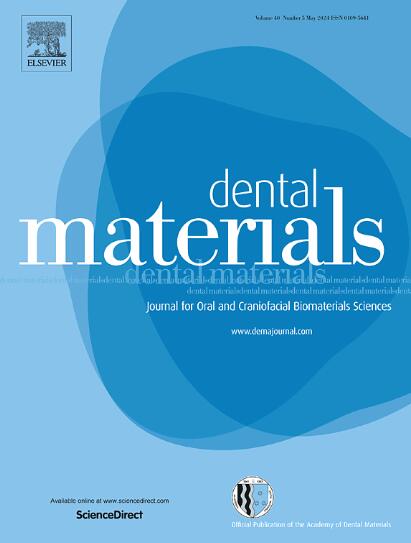The preventive effect of silver diamine fluoride-modified salivary pellicle on dental erosion
IF 6.3
1区 医学
Q1 DENTISTRY, ORAL SURGERY & MEDICINE
引用次数: 0
Abstract
Objective
To investigate the preventive effect of silver diamine fluoride (SDF) modified salivary pellicle (SP) against dental erosion.
Methods
Enamel and dentin blocks allocated into 4 groups (n = 30 each). Blocks in Group SDF+SP were treated with SDF and SP. Blocks in Group SDF were treated with SDF. Blocks in Group DW+SP were treated with deionized water (DW) and SP. Blocks in Group DW were treated with DW. The blocks were subjected to an erosive challenge at pH 3.2 for 2 mins, 5 times per day for 14 days. Salivary pellicle morphology was assessed by atomic force microscopy (AFM). Crystal characteristics, percentage microhardness loss (%SMHL), surface loss, and surface morphology were assessed by X-ray diffraction (XRD), microhardness test, profilometry, and scanning electron microscopy (SEM), respectively.
Results
AFM revealed a modified pellicle morphology in Group SDF+SP. XRD of both blocks revealed hydroxyapatite, silver chloride, silver phosphate, and silver fluoride in Groups SDF+SP and SDF. Fluoroapatite was found in Group SDF+SP only. %SMHL ( ± Standard deviation in %) of Groups SDF+SP, SDF, DW+SP, and DW were 33.4 ± 2.2, 38.6 ± 2.2, 50.3 ± 2.2, and 58.3 ± 2.4 in enamel and 16.1 ± 2.2, 19.7 ± 2.1, 32.8 ± 2.1, and 39.0 ± 2.3 in dentin, respectively. The presence of SDF and SP reduced %SMHL in both blocks (p < 0.001). The surface loss ( ± Standard deviation in μm) of Groups SDF+SP, SDF, DW+SP, and DW were 3.6 ± 0.7, 4.1 ± 0.4, 5.3 ± 0.5, and 7.0 ± 0.6 in enamel and 5.4 ± 0.6, 6.1 ± 0.5, 9.1 ± 0.7, and 9.2 ± 0.5 in dentin, respectively. The presence of SDF and SP reduced surface loss in enamel and dentin blocks (p = 0.031 and p = 0.002, respectively). SEM showed enamel surface remained relatively smooth and partially dentinal tubule occlusion on dentin blocks in Groups SDF+SP and SDF.
Conclusion
SDF had a positively synergistic effect with SP. SDF-modified salivary pellicle provided a superior protective effect against dental erosion.
二胺氟化银改性唾液胶粒对牙齿腐蚀的预防效果。
目的研究经二胺氟化银(SDF)修饰的唾液胶粒(SP)对牙齿腐蚀的预防效果:将釉质和牙本质块分为 4 组(每组 n = 30)。SDF+SP 组用 SDF 和 SP 处理牙块。SDF 组块用 SDF 处理。DW+SP 组块用去离子水(DW)和 SP 处理。DW 组块用 DW 处理。在 pH 值为 3.2 的条件下,对区块进行侵蚀性挑战,每次 2 分钟,每天 5 次,持续 14 天。用原子力显微镜(AFM)评估唾液颗粒形态。通过 X 射线衍射 (XRD)、显微硬度测试、轮廓仪和扫描电子显微镜 (SEM) 分别评估了晶体特征、显微硬度损失百分比 (%SMHL)、表面损失和表面形态:原子力显微镜显示 SDF+SP 组中的胶粒形态发生了改变。两块材料的 XRD 显示,SDF+SP 组和 SDF 组均含有羟基磷灰石、氯化银、磷酸银和氟化银。只有 SDF+SP 组发现了氟磷灰石。SDF+SP组、SDF组、DW+SP组和DW组在釉质中的SMHL%(± 标准偏差,单位为%)分别为33.4 ± 2.2、38.6 ± 2.2、50.3 ± 2.2和58.3 ± 2.4,在牙本质中分别为16.1 ± 2.2、19.7 ± 2.1、32.8 ± 2.1和39.0 ± 2.3。SDF和SP的存在降低了两个区块的SMHL%(p 结论:SDF和SP具有正向协同作用:SDF 与 SP 具有积极的协同作用。经 SDF 改性的唾液胶粒对牙齿侵蚀具有卓越的保护作用。
本文章由计算机程序翻译,如有差异,请以英文原文为准。
求助全文
约1分钟内获得全文
求助全文
来源期刊

Dental Materials
工程技术-材料科学:生物材料
CiteScore
9.80
自引率
10.00%
发文量
290
审稿时长
67 days
期刊介绍:
Dental Materials publishes original research, review articles, and short communications.
Academy of Dental Materials members click here to register for free access to Dental Materials online.
The principal aim of Dental Materials is to promote rapid communication of scientific information between academia, industry, and the dental practitioner. Original Manuscripts on clinical and laboratory research of basic and applied character which focus on the properties or performance of dental materials or the reaction of host tissues to materials are given priority publication. Other acceptable topics include application technology in clinical dentistry and dental laboratory technology.
Comprehensive reviews and editorial commentaries on pertinent subjects will be considered.
 求助内容:
求助内容: 应助结果提醒方式:
应助结果提醒方式:


